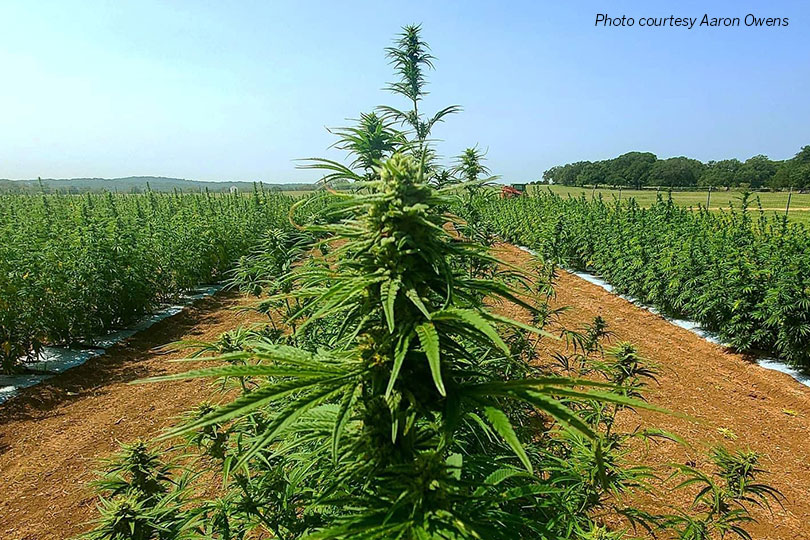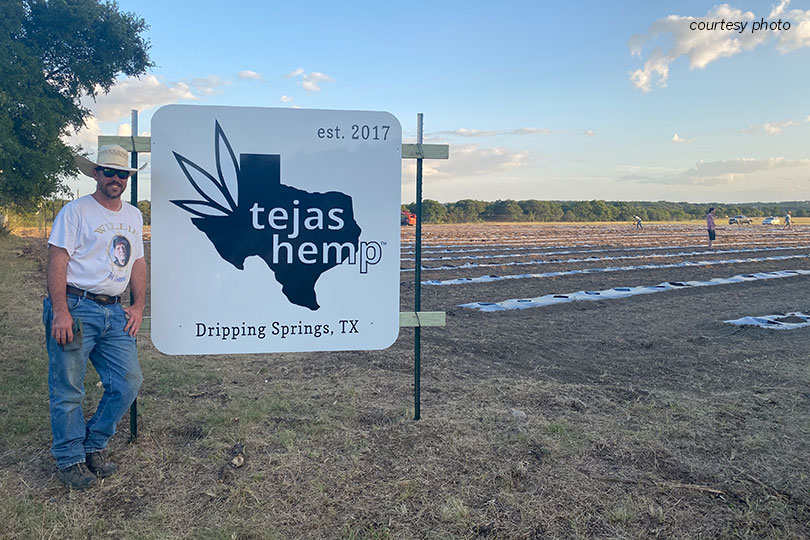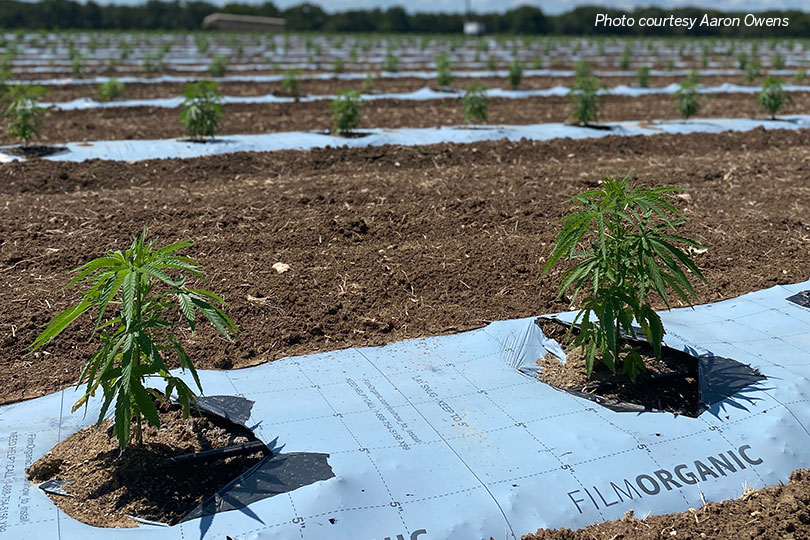By Jennifer Dorsett
Field Editor
Since 2015, the owner of Tejas Hemp, Aaron Owens, has successfully marketed a line of cannabidiol (CBD) products in Texas. After growing hemp in the Lone Star State became legal in 2019, the Hays County Farm Bureau member was ready to give it a try.
Owens, a West Texas native and longtime goat and cattle rancher, has been working with a Colorado-based partner on an exclusive CBD extraction process for several years.
“I’ve been ranching full time in Ozona for about 15 years, and I’ve been building my brand, Tejas Hemp, for the last four or five years retailing products,” he said. “It’s our first shot at production, so I just decided to plant a couple of acres and try my hand at it.”
There were some challenges along the way, including sourcing enough water for the crop. When the plants first started growing, Owens was watering at a rate of 2,000 gallons per acre per day. But during the plants’ bloom period, he was sending anywhere from 5,000-6,000 gallons of water per acre into his fields, necessitating a new water well.
“If you’re trying to maximize the oil properties and maximize the flower yields, which is what we were trying to do, you’re looking at about 5,000 gallons per acre per day,” he said. “But hemp can be a drought-resistant crop. If you had a bunch of hemp plants on the open range and it didn’t rain, they’d live. They just wouldn’t get very big. It just depends on what you’re trying to do with the plants, and we’re looking at flower production. So, we needed lots of water.”
Armyworms and fire ants caused some issues, and the ongoing coronavirus pandemic presented challenges, too.
“The biggest challenge with COVID was just sourcing supplies and equipment. Usually, we’d go down to the store and buy a piece of equipment, but the pandemic really set suppliers back in terms of logistics,” he said. “We needed a sprayer to spray for caterpillars. I tried to buy one, and they were six weeks out. That wouldn’t work because I had to have it the next day, so I drove to San Angelo and bought a firefighting rig and made that work for spraying.”
But overall, Owens feels like he had a good first year with the fast-growing crop.
“It was a bumper crop. We were just hoping for knee-high or thigh-high plants, and we got up to five and six feet tall. I germinated 5,000 seeds in early June and planted them in the ground on July 17,” he said. “Then on Oct. 17, we harvested our first acre. On Halloween weekend, we harvested our second acre for about 4,000 plants total.”

Instead of trying to grow a big crop on lots of land, he focused on growing just two acres of hemp, what he calls “boutique farming.”
That’s because current market prices don’t support industrial-scale costs.
“We’re in the mom-and-pop scale. We’re not out there on tractors. This is all by hand, boutique stuff,” Owens said. “When you’re farming hemp biomass for extraction of CBD oil at scale, the cost of production on biomass with tractors, or mechanized industrial production, is $2 per pound. But the current market value of commodity-traded CBD biomass is about 50 cents. In 2020, the last thing you wanted to be was a large-scale CBD biomass farmer, because the market was disappearing. I knew I didn’t want to do that. I focused on finding genetics for a plant variety that no one else on the market had, and it paid off.”
When it came to plant genetics, though, Owens still had trouble finding what he was looking for, even with his industry contacts and connections he’s made through his partnership in Colorado.
“I have that little bit of an advantage because of my networks and industry experience, but even I had my challenges and my struggles,” he said. “The biggest battle is finding genetics that you can trust and finding a source that will be accountable. Because when these guys come in from Oregon and sell $250,000 worth of seed to a co-op in Texas and drive off, and then those seeds don’t act like they were supposed to, there’s no real insurance or anything yet where you can hold those people accountable. That leaves us, the farmer, in a huge pickle.”
It’s a difficult issue with no easy answer besides more time and research. According to Owens, hybridized hemp plant genetics are generally not stable until the breeder has reached F10, or the tenth generation after the initial hybridization.
“If you’re trying to take a boutique strain, something no one else has that’s not stable, and merge it with something stable, you need to get to an F10 before you’ve ironed out all the phenotypes to really have something that will perform consistently,” he said. “If you don’t have stable genetics, you can suffer from things like hermaphroditism, or self-pollinating females that will seed your crop when you’re not trying to seed your crop.”
For the industry to really grow, Owens believes more emphasis needs to be placed on reliable seed genetics.
“One of the most important things we can do, and something I’m going to be focused on as we move forward, is securing and proliferating appropriate genetics, not only for this climate and geography but for the political climate,” Owens said. “We need dependable genetics that fit Texas and that fit the political climate, so people can have success with what they farm.”
But despite the struggles and challenges, Owens thinks there is a secure future for hemp production in Texas.
“The future of all of this for the Texas farmer, in my opinion, is going to be something called the tri-crop, where we can commercially produce hemp at scale with tractors and equipment, and we’ll be able to monetize the fiber, the grain and the biomass, all three. That’s when the Texas farmer will be able to make money in production,” he said. “In order to have that, we must have processing facilities set up to be able to take that material, when we harvest it and dry it and secure it through a mechanized system. Basically, the future is bright, and the direction is tri-crop. We just need the support infrastructure, so our farmers can get to work.”


